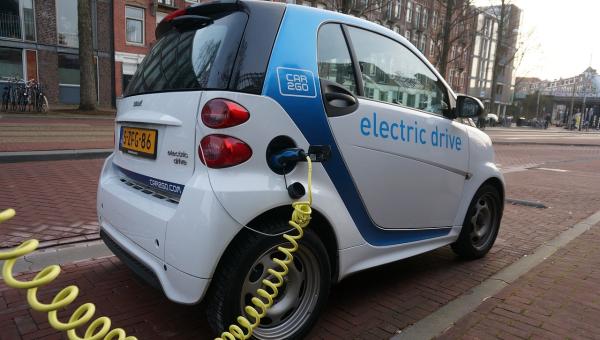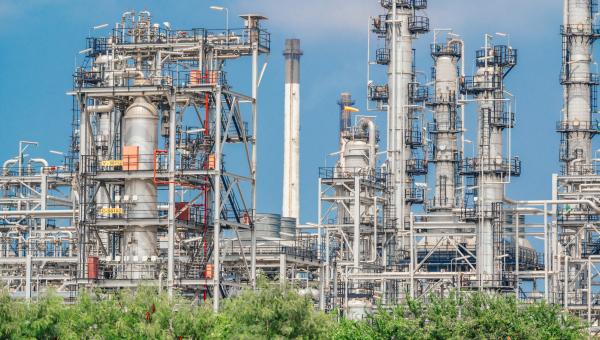Question 90: What determines the minimum feedrate for a fixed bed reformer? What process indicators would tell you that the feedrate is too low?
Rick Grubb (Chevron USA)
Besides mechanical limitations, such as pump capacities, flowmeter ranges, control valve sizes, etc., the process factors that determine the minimum feed rate of a fixed-bed reformer are:
- Flow distribution in the reactors
- Heat of reaction dissipation in reactors
- Flow distribution in furnaces
- Phase separation in exchangers
Most refineries set the feed rate minimum at 40% of design (liquid hourly space velocity of 0.6 volumes of feed per volume of catalyst per hour). The minimum space velocity for continuous operation is 0.8 v/v/hr.
At low feed rates, the most critical issue is free radical cracking. When flow through a catalyst bed is low, the heat is generated by hydrocracking faster than it can be carried away. At a certain temperature, the hydrocracking changes from normal hydrocracking to free radical cracking, also called demethylation. Free radical cracking is essentially thermal hydrocracking in which feed molecules are totally cracked to methane with a huge heat release. This is the most important effect of low feed rate to watch for, because at such high temperatures, catalyst can fuse and destroy reactor internals in internally insulated (cold wall) reactors. In a hot wall reactor, such an excursion could result in a reactor outlet piping rupture if not caught soon enough.
The first signs of free radical cracking in one or more reactors (usually not the first one) are:
- Recycle specific gravity starts to rise
- Reactor DT’s start to drop and may go positive in the last and next to last reactors
- C1/C2 ratio in the recycle gas starts to rise above the normal 1.2-1.4:1
- Reformate color turns to a darker yellow
- Net hydrogen yield per barrel of feed starts to drop off
For normal hydrocracking, the total DT is 200-250°F. For demethylation the DT can be as high as 1200-1400°F. So, a significant drop in individual reactor DT’s can be an indication of free radical cracking.
Russ Weinhammer/Joe Zmich (UOP LLC)
UOP has traditionally used a minimum liquid hourly space velocity (LHSV) of 0.75 hr-1 or 50% design feedrate whichever is greater. For units with lower design LHSV UOP advises maintaining the combined feed mass flow above 50% of the design value. The main process implication with low LHSV is an increase in cracking reactions. The increase in cracking leads to decreased reformate and hydrogen production, lower reactor delta T’s, lower recycle gas H2 purity, increased stabilizer off gas and LPG flow, and increased C1-C4 yield.
Javier Quintana (Valero Energy)
Valero has experience operating as low as 0.6 LHSV in a fixed bed reformer, although such operation was accompanied by an elevated H2/HC ratio in order to ensure good flow distribution through the catalyst beds.
Question 91: In a catalytic reformer with a given pressure, severity, and feed quality (N+2A), what are the major factors that determine the C5+ yield? How do you optimize yield? Have you quantified the impact of pentane and/or hexane content in the feed?
Michael Newton (Roddey Engineering)
Setting pressure, severity, and feed quality limits you on any significant “knobs to turn” in determining the C5+ yield. If you assume that LHSV is also fixed, there are two factors that can impact C5+ yield.
Reactor Inlet Temperature Profile – typically running a “downhill” profile will give you a slightly higher C5+ yield and will lower overall coke make in the unit.
Water Chloride balance – having an over-chlorided catalyst will result in more cracking and lower C5+ yields. Under-chlorided – higher deactivation, higher yield, higher temp required.
Yields can be optimized by maintaining a good water chloride balance and working with your technology supplier or consultant in determining the best temperature profile and recycle gas rate to obtain the desired cycle length or total coke make.
Rick Grubb (Chevron USA)
We’ve noticed that catalyst fouling and feed distillation have an effect on C5+ yield in addition to the items listed above. As the catalyst fouls the C5+ yield decreases. We’ve also seen that as the distillation gets heavier near the endpoint the C5+ yield also decreases. As the distillation gets heavier near the initial boiling point the C5+ yield increases slightly. With that said, we don’t typically push for C5+ yield as much as we consider it a result from the other refinery optimizations. We target the crude distillations to maximize the product slate for optimum profits and octane blending between the chemical plants and the mogas blending demands. In other words, the short range planners take distillation and catalyst age into account when choosing distillations and octanes.
We do monitor the C5+ yield to ensure the unit is operating well. We’ve implemented process monitoring standards to ensure consistent overview between the different units and engineers. These standards allow for consistent monitoring techniques and help bridge gaps between personnel transfers.
Question 92: What criteria do you use to determine end of run (EOR) catalyst life for a CCR? How many regeneration cycles have you achieved between catalyst replacements?
Willie Morrissette/Joe Zmich (UOP LLC)
There are a number of considerations in determining the End of Run for a catalyst cycle in CCR operations. Refinery economics are typically the ultimate factor used for determining when to replace CCR Reforming catalysts. The useful life of a CCR catalyst is impacted by the operation of the unit and is a function of the ability to maintain the proper metal and acid function of the catalyst as well as the condition of the catalyst base. UOP’s CCR PlatformingTM catalyst can achieve very long life because UOP reactor and regenerator operate at optimum conditions. A number of Platforming Unit operations have achieved in excess of 800 regeneration cycles prior to making a catalyst change out. Key considerations for catalyst change out can include one or more of the following:
1.An inability for the catalyst to achieve optimal platinum dispersion through regeneration.
2.An increase in chloride injection requirements during regeneration resulting from a reduction in regenerated catalyst surface area as compared to fresh catalyst and leading to increased chloride loss in the reforming reactor section during normal operation.
3.An increase in catalyst fines production due to irreversible phase damage to the catalyst base resulting in decreased catalyst surface area, increased catalyst attrition, loss in catalyst activity, and fines-induced process equipment plugging problems.
4.A loss of catalytic metal and acid function of the catalyst due to accumulation of poisons such as metals on the catalyst eventually resulting in loss of catalyst activity, selectivity, or regenerability.
5.A loss of catalyst activity resulting in operations approaching the equipment or unit design constraints.
6.An advancement in catalyst technology resulting in sufficient economic benefit to replacing the catalyst before it otherwise reaches the end of its life.
7.A scheduled unit operating shut down providing a convenient opportunity for catalyst change out.
Javier Quintana (Valero Energy)
The EOR criterion for catalyst change out in a CCR is an economic optimization considering a number of factors, including:
–Ability to meet process objectives (rate, octane)
–Chloride consumption and treating costs
–Phase change content of catalyst inventory
–Level of accumulated contaminants (Fe, Si, etc)
–Ability to disperse platinum (activity, yield)
Valero’s expectation for ultimate life of CCR catalysts is in excess of 600 cycles for early generation CCR units, and in excess of 700 cycles for recent generation units. Not all units reach these targets, but any such shortfall is normally directly attributable to operating issues that lead to the anomalies indicated in the list of factors above.
Question 93: On a CCR, what causes the regenerator chlorination zone to plug off before the regeneration zone?
Ka Lok/Joe Zmich (UOP LLC)
Assuming that the question relates to the inner screen of the chlorination zone of a UOP Atmospheric CCR regeneration section relative to the burn zone, the most likely cause of this is failing to operate the CCR regeneration section burn zone per the UOP General Operating Curve. If the catalyst circulation rate for given oxygen concentration exceeds the maximum indicated by the curve, it’s likely that catalyst with higher than desired coke will enter to the chlorination zone leading to catalyst damage. The damaged catalyst can be smaller and fracture into dust and chips in the chlorination zone leading to plugging of the chlorination zone screen.
Some licensees have observed an increased slot width in the chlorination zone after a long time in operation. An increase in slot width increases the tendency of the screen to foul with catalyst chips or smaller diameter catalyst.
Question 94: In monitoring catalytic reformer operation, how often do you perform a feed/product analysis and what analytical methods do you use? How often do you perform a mass balance and what is the acceptable mass balance closure? What is a typical mass balance closure?
Michael Newton (Roddey Engineering)
Units were the feed properties are relatively constant need to be monitored much less than those were the properties change often.
For material balances during performance evaluation, accuracy should be within +/-1%. For daily monitoring, +/-2% is acceptable. All balances and monitoring require good data from the lab and making sure that meter data is input and calculations performed correctly.
Question 95: How often do you perform CCR and cyclic reformer turnarounds? What determines the turnaround interval? What actions can you take to extend the turnaround cycle?
Javier Quintana (Valero Energy)
Valero’s best practice guideline for reformer turnarounds is currently 4-6 years, but eventually we will target 10 years. With the longer turnaround horizon, catalyst condition in a CCR unit can be managed with on-the-fly change out, which has been demonstrated several times in practice, while in cyclic units, a reactor can be changed out while the remainder of the unit is operating.
In CCR units, the primary determinant of turnaround timing is plugging of the lead reactor center screen with catalyst fines, due to incomplete elutriation or misoperation in the regeneration section, leading to fines generation downstream of the elutriation system. Ultimately, regulatory requirements related to inspection frequency will govern the turnaround timing if the catalyst condition is maintained such that no such reactor fouling occurs. In the case of cyclic units, mechanical issues with motor-operated valves (MOVs) are key factors with turnaround timing, along with any regulatory inspection requirements.
Extending the turnaround frequency begins first and foremost with maintaining good catalyst quality. Units that operate with lower coke levels on spent catalyst (i.e., lower severity operation) generally have longer periods between turnarounds. Key factors to maintain include ensuring complete fines removal in the elutriation system, ensuring good mechanical condition of the catalyst piping such that there are no protruding lips or rough edges that can generate catalyst fines, proper drying and cooling of the catalyst in the regeneration equipment, and ensuring that the regenerator operating curve is followed to ensure complete combustion occurs in the burn zone, with no coke slip into the chlorination section. Episodes of coke slip lead to overheating of catalyst, with attendant phase change which is more susceptible to attrition.
Also essential is to maintain stable operation, with minimum number of emergency shutdowns. Thermal cycling of the reactors is associated with internals damage, although slow, regulated transfer of catalyst out of the reactors during cooldown can be used to largely eliminate bed pressure increases that are associated with internals damage. Additionally, it is important to monitor the reactor operation to ensure catalyst pinning does not occur, as pinning leads to rapid catalyst attrition and fouling of reactor centerpipes. Such events usually lead to the need to open the reactors for cleaning and repairs shortly after such events.
Chris Polaniecki/Joe Zmich (UOP LLC)
The frequency of a turnaround on a UOP CCR PlatformingTM unit depends largely on refinery and local government requirements. The reactor internals of the Platforming™ process should be thoroughly inspected on a routine basis. The first inspection should come after the initial two years of operation. Most licensees are increasing the time between turnarounds with some looking to go to more than an 8 year run time.
Although many factors contribute to long operational runs and unit safety, preventative maintenance is probably the most important. A proper and thorough unit inspection during scheduled turnarounds not only results in extended run lengths and maximum safety but also greatly reduces the probability of unscheduled shutdowns. UOP can provide a comprehensive checklist of all major unit equipment and piping recommended by UOP for inspection during a turnaround. This checklist includes recommendations for inspection and repair of piping, compressors, combined feed exchanger, fired heaters, and reactors.


